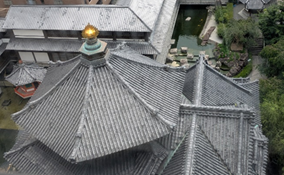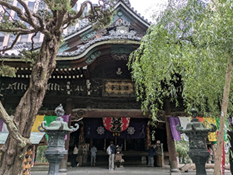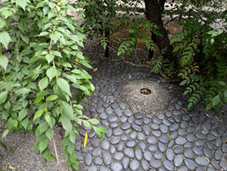Gravity(Attraction) of Kyoto Ⅷ Why do they eat conger eels at the Gion Festival? During the Middle Ages, the Rokkakucho Raw Fish Offerings were made up of women.
Yoshie Doi
 |
 |
Photo taken on July 8, 2025 at Rokkakudo.
Until the end of the Edo period, the lottery ceremony for the Gion Festival was held at Rokkakudo.
The navel stone in the grounds of Rokkakudo
The origins of eating conger eel in Kyoto in July date back to the Edo period. Conger eels are hardy fish, and they were able to survive and be transported from Naniwa to Kyoto even without water. Drawings of fish shops in Nishiki Market from the Edo period show many fish lined up. Looking at drawings from the Middle Ages, we can see that women supported Kyoto’s food culture as fish merchants.
When talking about fish in medieval Kyoto, one would think that the main fish were freshwater fish such as carp, crucian carp, and sweetfish caught in the Kamo River, Katsura River, and Uji River, but Rokkakucho raw fish merchants were already active there. Although they held the status of tribute to the Imperial Court, documents show that the Rokkakucho raw fish tribute holders were very active, and a picture (Kyoto Monthly Manners and Customs Fan-shaped Screen, Koenji Temple Collection) shows that these raw fish merchants were made up of women. It’s great to see that women were instrumental in supporting the food culture of medieval Kyoto.
The Rokkakucho ruins, discovered in 2017, have unearthed a large amount of fish, shellfish, bird and small mammal bones, as well as catfish, carp, conger eel, herring, mullet, grouper, yellowtail, yellow porgy, black porgy, red sea bream, tilefish, raccoon dog, cow, deer, wild hare, bear, rat, pheasant, heron, crane and duck.
This shows that seafood has been eaten in Kyoto since the Middle Ages, not just dried or salted fish brought from distant ports.
During the Gion Festival, conger eels were allowed to be purchased in Kyoto at the discretion of Yasaka Shrine, and it was during this month that the festival took place. In an era when it was difficult to transport fresh fish, conger eels were very hardy and could be transported alive from Naniwa to Kyoto even without water. This coincided with the season for conger eels, which are said to taste better after drinking the waters of the rainy season, and conger eel dishes became established.
The origin of the word “hamo” is said to be “hamu” (to eat). It is a ferocious and powerful fish that will bite anything with its sharp teeth. In other prefectures, conger eels are a fish that is discarded after being used to make soup stock. In Kyoto, we can be said to be a full-fledged chef if they can cut the bones (Honekiri) of conger eels, and we can enjoy cooking this fish that would normally be discarded.
Conger eel dishes include boiled conger eel, sashimi, conger eel cooked in kudzu, conger eel shabu-shabu, conger eel sushi, grilled conger eel, and fried conger eel, and because of the hospitality shown, it came to be called the Conger Eel Festival.
It is said that the amount of conger eel traded in Kyoto is about 10 times that of Tsukiji Market in Tokyo (around 1,000 tons per year), and the trading volume from early summer to autumn appears to be the highest in the country.
There was a particular surge from around July 14th to 16th, when the Yoiyama (first festival) of the Gion Festival was held, and it peaked around July 17th, when the Yamahoko Procession (first festival) and Shinko Festival were held, with some trading at nearly 10 tons in a single day
For some reason, during the Edo period, chefs from Kumamoto Prefecture (Hosokawa Domain) cooked and served conger eel. Kyoto is the home of conger eel cuisine, but it is said that chefs from Kumamoto and Kyoto may have had contact with each other since the Edo period, but there is no solid evidence.
Conger eels have many small bones, so a bone-cutting knife was developed to make seven or eight cuts every centimeter to make them more delicious to eat. The cuts are made every 1 inch (about 3 cm). There are also conger eel bone-cutting knives made specifically for cutting the bones of conger eels. This is a craftsman’s technique in which the knife cuts only into the flesh and bones, leaving only a thin layer of skin.
In Kyoto, one is considered a full-fledged chef if he can debone a conger eel, just as one is considered a full-fledged chef if he can cook fish that would normally be thrown away in a delicious way.
When I spoke to the owner of a conger eel restaurant, he told me that conger eel is most delicious in the fall, but in Kyoto it is most commonly eaten during the Gion Festival.
Conger eels are lined up in a picture of a fish shop in Nishiki Market in the Edo period. In July, during the Gion Festival, conger eels could be purchased in Kyoto at the discretion of Yasaka Shrine. It is said that this is why people began to eat conger eels in the summer.
The natural refrigerator that used Kyoto’s cool underground water was also used to preserve fish. (Continued in the next issue)
The end of document
Translated by Masami Otani
